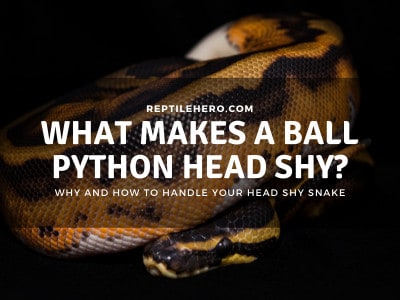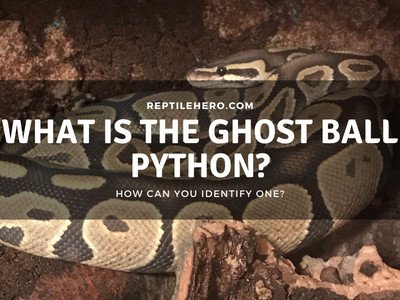Can Ball Pythons Show Affection?
Like most snakes, many believe that ball pythons cannot be affectionate. But is this true? Can they form bonds like dogs and cats? As keepers, it is our job to worry and cater to the needs of our pets—whether physical or emotional.
Most owners believe that ball pythons can show affection but it is not yet scientifically proven. They have behaviors that indicate a preference for other ball pythons, especially during mating. Some keepers also share stories of how their ball pythons show affection to them.
Ball pythons are different from us, especially in socialization. But can ball pythons be affectionate to their fellow snakes and owners? Can they experience emotions like happiness? All of these questions will be answered when you read until the end!
How Do Ball Pythons Show Affection to Other Pythons?
As solitary animals, ball pythons are not known to normally show affection to other ball pythons, but they show signs of attachment during mating. They can show a preference for their mate by 1) rubbing, 2) coiling together, and 3) tail locking.
These are some of the anecdotal proofs that ball pythons have the capability to “like” and show preference for other pythons. This will differ for each individual. But this is not necessarily equivalent to the affection we, humans, show each other.
It is widely known that ball pythons, like most animals, mate with each other as an instinctual response, not as an emotional choice like us humans. This means that pythons do not mate out of love. Rather, they do so out of an instinctual need for preservation.
1. Rubbing
Rubbing is one of the few behaviors ball pythons show as affection to their potential mating partner. This behavior is often seen in males during mating but some females also do this.
Rubbing is one of the first courting gestures made by ball pythons during mating. This means that they are interested to mate with the partner they “like.”
Why did we assume that ball pythons “like” a certain partner, don’t they view all ball pythons the same? Well, no. There are ball pythons that will not be receptive to a certain partner for unknown reasons.
2. Coiling Together
As a form of affection, coiling together is sometimes done by ball pythons. This behavior is commonly observed during mating but it can also happen in other scenarios.
Again, coiling is a sign of affection due to its part in the mating process of ball pythons. This is a behavior that indicates the compatibility of the pair—that they “like” each other.
The behavior of coiling together in ball pythons will look like hugging or snuggling.
There are also reports stating that wild ball pythons coil together in the same burrow. This should not be assumed as a sign of “affection” but more as a survival instinct.
Many experts state that ball pythons gather at the same burrow not for socialization, but additional security and food source.
Warning: Ball pythons should not be cohabitated together unless for breeding. Cohabitation can cause stress, the spreading of illnesses, premature breeding, injuries, and cannibalization.
3. Tail Locking
Ball pythons that lock tails can imply that they are affectionate with each other during the mating period. As the final stage of the mating process, tail-locks can last 2 hours up to 2 days.
Tail locking is the main mating process in snakes, including ball pythons. At this stage, the pair is receptive to each other and they are now accustomed to each other so they mate [1].
So compared to the other mating behaviors I mentioned, tail locking is a sure sign of compatibility between ball python pairs.
Then again, this is not the same affection we experience as humans. Still, it is considered by many as a ball python’s act of “liking” another.
Does Your Ball Python Like You? (3 Signs)
Many experts state that ball pythons do not essentially “like” their owner similar to what cats and dogs experience. But they are known to trust and tolerate the presence and touch of their keepers.
There are some keepers who suggest that ball pythons can indeed become attached to their owners.
Based on their observations, a ball python wants to be with you if they show: 1) head contact, 2) pulsating squeeze, and 3) tail wagging.
1. Head Contact
Many assume that if a ball python rubs its head on its owner, it is a sign of affection. Hence, allowing touch and exposing its head is also a sign of trust and comfort between the snake and the owner.
For ball pythons, their head is the most vulnerable part of their body. That is why if your snake allows you to rub its head area, then there is a high chance that it is comfortable with you.
There are also stories suggesting that a ball python can show affection to their owner. Although these are interesting stories, we are not 100% sure what they feel during these scenarios.
In my experience of having Choco, my 6-year-old ball python, I am sure that he tolerates and is comfortable with me handling him. He even lets me touch and pet his head.
But I did not observe even once, him seeking out attention and love from me. So if you saw some videos of ball pythons that seem “affectionate” to their owners, this is not always the case.
>>Learn more about ball python rubs in our article why does a ball python rub its face
2. Pulsating Squeeze
There are also some reports that ball pythons show affection by wrapping around the neck or arm of a person and then making a pulsating motion. Many assumed that this behavior indicates that they like the person.
Such behavior is also associated with a ball python’s mating season. This “pulsating” body motion indicates interest in a potential mate. But they can also do it to their owner.
But this is, again, just anecdotal. There is no scientific evidence available to back this up other than the fact that they do this during mating, with the partner they like.
3. Tai Wagging
Some keepers assume that a ball python likes its owner if it wags its tail while being handled. This behavior is also associated as a part of their courtship process during mating.
If you handle your ball python and it seems clingy while wagging its tail, it might be a sign that it likes you. Like all other behaviors listed above though, this is just an assumption made by keepers who have experienced their ball pythons do these.
Please take note that there are times when a ball python wags its tail due to other reasons.
Tail-wagging can sometimes be a sign of defensiveness in ball pythons. It might even be a warning that it will bite if you get closer.
>>Learn more about signs a ball python will bite in our article about why did your ball python attack you?
How Can You Bond With Your Ball Python?
The primary way to bond with a ball python is through handling—specifically, choice-based. Experts show that choice-based handling will encourage a ball python to trust its handler and grow more comfortable in its presence.
Although you must pick up a ball python for times when cleaning and water refills are necessary, it’s not the best way to form a good bond with your snake.
Choice-based handling is a gradual and gentle way of socializing a ball python to let it grow accustomed to you. This is a slow yet rewarding process that does not “force” the snake to trust you.
Yes, you can just handle your ball python regularly and it will eventually tolerate you. But this is a “forceful” way and the ball python may associate you as a threat.
Each ball python has a different temperament which greatly affects how easily they can tolerate handling and trust their owner. Some are more confident than others, while others are more reclusive.
The main goal of choice-based handling is to let the ball python freely do what they want in your presence. This method can make a ball python associate you as a neutral part of its environment, meaning, a non-threat.

Bonding through proper handling can benefit both you and the ball python. They will be more confident which will lead to less stress and, at the same time, you can enjoy hanging out with your beloved pet!
Fun Fact: There is a study that proves a snake’s ability to recognize its owner through smell. Interestingly enough, the test is made for one snake that is kept in minimum care and another one in an enriching environment. And the result shows that the enriched snake was better at recognizing its owner.
4 Signs That a Ball Python is Happy
Ball pythons cannot express happiness like we humans do. However, if they have: 1) good appetite, 2) handling tolerance, 3) curiosity to explore, and 4) casual movements, many keepers consider them to be “happy” and contented in their living conditions.
There is no accurate way to determine whether or not a ball python is happy. But there are assumptions that being comfortable and being happy are somewhat the same concept for ball pythons. Less stress equals a “happy” snake!
1. Good Appetite
A ball python that eats well is a good sign that it is “happy” in its current condition. Food response is a great way to indicate whether a ball python is in a great state or not.
A ball python will refuse to eat it might be due to overfeeding, husbandry problems, sickness, and stress. So if all of these factors are addressed and resolved, there is a great chance a ball python would not refuse food!
I had my ball python Choco for 5 years and never did he refuse a mouse during feeding time. But is he happy? I do not know for sure as they cannot show it like how dogs and cats do. Nonetheless, I can assume that he is contented and healthy in my care.
2. Handling Tolerance
If a ball python tolerates handling, then it is likely “happy.” In contrast, ball pythons that are skittish and fearful during handling are more likely to be wary rather than comfortable.
If your ball python tolerates handling, it may experience a less stressful life which naturally means that it is comfortable in your presence.
Hatchlings are the ones often uncomfortable during handling and this is natural. But with positive handling experience, they will eventually learn that you are not a threat which will result in their comfort.
3. Curiosity to Explore
As opposed to the common belief, ball pythons are curious to explore. If a ball python has the option to explore in an appropriately sized enclosure, it can result in better stimulation and thus a “happier” snake.
The phrase “a hiding ball python is a happy one” is an outdated term used by keepers that keep their snakes within the minimum requirement.
Ball pythons, if provided with enrichment, can be inquisitive in their environment.
Experts state that the reason why most ball python owners suggest that their snakes only like to hide is because they are being kept in an environment with no enrichment.
Providing enrichment through tank features such as clutter, a climbing area, and a larger space greatly affects a ball python’s behavior. It stimulates the neurons in a ball python’s brain which are associated with exploring.
4. Casual Movements
A ball python that moves calmly and slowly indicates that it is comfortable and “happy.” If they are seen moving and jittering quickly, then there might be a problem related to illnesses, husbandry, and stress.
In addition, if a ball python sees you and still moves calmly, then it might be getting accustomed to or comfortable around your presence.
This is an indicator of a “happy” ball python that experiences little to no stress.
On the other hand, a ball python that is trying to escape its enclosure might not be happy at all due to several possible problems.
What Emotions Do Ball Pythons Feel?
Ball pythons, like most vertebrates, can feel emotions due to neurochemicals like dopamine and serotonin linked to their feelings. They are known to feel emotions like:
- Fear
- Distress
- Anxiety
- Excitement
- Anticipation
- Pleasure
- Depression
Ball pythons show fear, distress, and anxiety by balling up or showing aggression to defend themselves from a possible threat. They will also retreat into hiding if they feel these emotions.
Excitement and anticipation are shown by ball pythons mostly during feeding time. Their receptiveness show focus and they can also anticipate feeding time using the day and night cycle.
So if you feed them during nighttime, then there is a high chance they will anticipate it.
Fun Fact: Reptiles, including ball pythons, have a similar brain functionality as mammalian brains. Which is a piece of strong evidence of reptiles having the capability to feel emotions.
For pleasure, ball pythons show this by being relaxed and comfortable in whatever they are doing. For example, when soaking mites away, ball pythons feel the pleasure of being relieved of itchy critters.
Lastly, depression is shown in ball pythons deprived of enrichment. Depressed ball pythons have little to no movement at all which leads to obesity. They also seem like dumb and lazy animals due to having no signs of being inquisitive.
Sadly, this is normal due to the chronic lack of neural stimulation.
Misunderstanding Ball Python Emotions
Visualize this, you are an elongated creature deprived of being able to stretch out in a small home. In addition to this, you do not know whether it is night or day and lose track of time.
You only see light during feeding time and there are no things inside your home besides a water bowl. How would you feel in this scenario?

There are many more possible emotions that a ball python might feel but overestimating this can lead to the anthropomorphization of the snake [4].
For example, if you saw your ball python hissing and looking to bite you might think it is angry, but this is not 100% true.
Displaying such behavior is simply their way of letting a predator know to back off. They do not get defensive just because they are frustrated and angry at you. In such a scenario, they might even be feeling fear the most!
Further Questions
Do ball pythons know their name?
Ball pythons do not know their names but can recognize sounds produced by humans. Especially if it is essential, a ball python can associate a sound with threat, feeding, or just the mere presence of a person.
Can ball pythons get sad or lonely?
Unlike humans, ball pythons are solitary animals and are naturally alone in the wild, so it can be assumed that they don’t feel sad or lonely. But they can feel depressed due to the lack of mental stimulation and enrichment in their environment.
Are ball pythons loyal to their owners?
Ball pythons are not loyal to their owners like how cats and dogs are. But they are known to show preference and can recognize the sound and scent of the person that takes care of them. There are even reports of ball pythons showing a preference for specific people.
Summary of Can Ball Pythons Show Affection?
It is not scientifically proven that a ball python can show affection. But based on behaviors like rubbing, coiling together, and tail-locking, they can show a preference for another ball python during the mating season.
Based on anecdotal evidence, some keepers state that ball pythons can show affection to their owners by allowing direct head contact, pulsating squeezes, and wagging their tails. To bond with ball pythons, it is recommended to implement choice-based handling to create a positive experience for the snake.
A ball python is “happy” if it has a good appetite, good handling tolerance, and curiosity to explore all while moving in a casual and calm manner. They can also feel emotions like fear, distress, anxiety, anticipation, excitement, and depression.
Sources
[1] https://digitalcommons.usu.edu/cgi/viewcontent.cgi?article=2004&context=etdx







